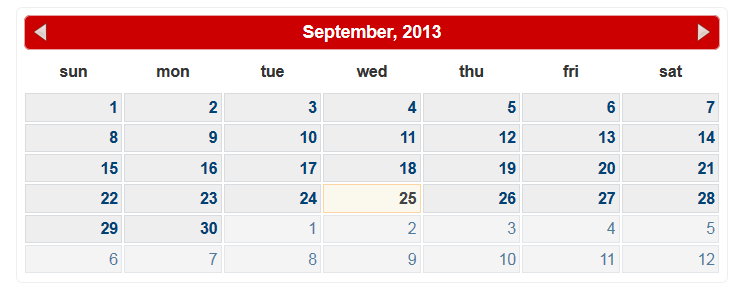【转译】使用PHP和AJAX制作日历
在很多网站,日历是一个必要的组成部分。通常这些日历是jquery的一个插件,但是也可以用php来实现。今天我将使用ajax技术展示一个月份的日历,可以通过左右箭头切换月份。由于是ajax,这个日历还有其他的优点,它是一个响应式的移动日历。在开始编写代码之前,我建议你先看看我们的demo.

文件结构:
在开始之前,让我们先为我们的文件定义一个清晰的文件夹结构:
- css-存放所有的css文件
- images-存放所有可能用到的图片
- templates-存放所有的模板文件 ### 第一步 编写HTML文件 ###
我们不使用任何特定的系统模板(如Smarty),我们将只使用我们自己写的一个简单的html模板。
templates/index.html
<!DOCTYPE html>
<html lang="en">
<head>
<meta charset="utf-8" />
<meta name="viewport" content="width=device-width, initial-scale=1.0, maximum-scale=1.0, user-scalable=0" />
<title>PHP AJAX Calendar</title>
<!-- add styles and scripts -->
<link href="css/styles.css" rel="stylesheet" type="text/css" />
<script src="http://ajax.googleapis.com/ajax/libs/jquery/1.3.2/jquery.min.js"></script>
</head>
<body>
<div id="calendar">
__calendar__
</div>
</body>
</html>
这个一个非常简单的index页面模板,我们在这定义了一个日历的父容器。另一个模板将会被用作日历的内部容器。
templates/celendar.html
<div class="navigation">
<a class="prev" href="index.php?month=__prev_month__" onclick="$('#calendar').load('index.php?month=__prev_month__&_r=' + Math.random()); return false;"></a>
<div class="title" >__cal_caption__</div>
<a class="next" href="index.php?month=__next_month__" onclick="$('#calendar').load('index.php?month=__next_month__&_r=' + Math.random()); return false;"></a>
</div>
<table>
<tr>
<th class="weekday">sun</th>
<th class="weekday">mon</th>
<th class="weekday">tue</th>
<th class="weekday">wed</th>
<th class="weekday">thu</th>
<th class="weekday">fri</th>
<th class="weekday">sat</th>
</tr>
__cal_rows__
</table>
这是因为对于ajax的请求,我们不需要返回任何东西,除了内部的日历内容。
第二步 PHP
给日历添加行为
index.php
// Get current year, month and day
list($iNowYear, $iNowMonth, $iNowDay) = explode('-', date('Y-m-d'));
// Get current year and month depending on possible GET parameters
if (isset($_GET['month'])) {
list($iMonth, $iYear) = explode('-', $_GET['month']);
$iMonth = (int)$iMonth;
$iYear = (int)$iYear;
} else {
list($iMonth, $iYear) = explode('-', date('n-Y'));
}
// Get name and number of days of specified month
$iTimestamp = mktime(0, 0, 0, $iMonth, $iNowDay, $iYear);
list($sMonthName, $iDaysInMonth) = explode('-', date('F-t', $iTimestamp));
// Get previous year and month
$iPrevYear = $iYear;
$iPrevMonth = $iMonth - 1;
if ($iPrevMonth <= 0) {
$iPrevYear--;
$iPrevMonth = 12; // set to December
}
// Get next year and month
$iNextYear = $iYear;
$iNextMonth = $iMonth + 1;
if ($iNextMonth > 12) {
$iNextYear++;
$iNextMonth = 1;
}
// Get number of days of previous month
$iPrevDaysInMonth = (int)date('t', mktime(0, 0, 0, $iPrevMonth, $iNowDay, $iPrevYear));
// Get numeric representation of the day of the week of the first day of specified (current) month
$iFirstDayDow = (int)date('w', mktime(0, 0, 0, $iMonth, 1, $iYear));
// On what day the previous month begins
$iPrevShowFrom = $iPrevDaysInMonth - $iFirstDayDow + 1;
// If previous month
$bPreviousMonth = ($iFirstDayDow > 0);
// Initial day
$iCurrentDay = ($bPreviousMonth) ? $iPrevShowFrom : 1;
$bNextMonth = false;
$sCalTblRows = '';
// Generate rows for the calendar
for ($i = 0; $i < 6; $i++) { // 6-weeks range
$sCalTblRows .= '<tr>';
for ($j = 0; $j < 7; $j++) { // 7 days a week
$sClass = '';
if ($iNowYear == $iYear && $iNowMonth == $iMonth && $iNowDay == $iCurrentDay && !$bPreviousMonth && !$bNextMonth) {
$sClass = 'today';
} elseif (!$bPreviousMonth && !$bNextMonth) {
$sClass = 'current';
}
$sCalTblRows .= '<td class=".$sClass."><a href="javascript: void(0)">'.$iCurrentDay.'</a></td>';
// Next day
$iCurrentDay++;
if ($bPreviousMonth && $iCurrentDay > $iPrevDaysInMonth) {
$bPreviousMonth = false;
$iCurrentDay = 1;
}
if (!$bPreviousMonth && !$bNextMonth && $iCurrentDay > $iDaysInMonth) {
$bNextMonth = true;
$iCurrentDay = 1;
}
}
$sCalTblRows .= '</tr>';
}
// Prepare replacement keys and generate the calendar
$aKeys = array(
'__prev_month__' => "{$iPrevMonth}-{$iPrevYear}",
'__next_month__' => "{$iNextMonth}-{$iNextYear}",
'__cal_caption__' => $sMonthName . ', ' . $iYear,
'__cal_rows__' => $sCalTblRows,
);
$sCalendarItself = strtr(file_get_contents('templates/calendar.html'), $aKeys);
// AJAX requests - return the calendar
if (isset($_SERVER['HTTP_X_REQUESTED_WITH']) && $_SERVER['HTTP_X_REQUESTED_WITH'] == 'XMLHttpRequest' && isset($_GET['month'])) {
header('Content-Type: text/html; charset=utf-8');
echo $sCalendarItself;
exit;
}
$aVariables = array(
'__calendar__' => $sCalendarItself,
);
echo strtr(file_get_contents('templates/index.html'), $aVariables);
我尽量为每行代码都加上了注释,目的是为了让你更加容易理解整个处理过程。开始我们创建了日历相关的当前日期很请求日期。然后我们生成日历表格,最后我们将模板的关键字替换掉。在Ajax请求时,我们只翻译日历内部的内容($sCalendarItself),否则我们将显示整个页面。
第三步 CSS
现在,我们的日历看起来不那么美观,因为只有html代码。让我们装饰一下我们的日历吧!
css/style.css
/* calendar styles */
#calendar {
-moz-user-select: none;
border: 1px solid #EEEEEE;
border-radius: 6px 6px 6px 6px;
color: #333333;
font-family: Arial,sans-serif;
font-size: 1.1em;
margin: 10px auto;
padding: 0.4em;
width: 90%;
}
#calendar .navigation {
background-color: #CC0000;
border: 1px solid #E3A1A1;
border-radius: 6px 6px 6px 6px;
color: #FFFFFF;
font-weight: bold;
padding: 1px;
position: relative;
}
#calendar .navigation .title {
background: none repeat scroll 0 0 transparent;
border-color: rgba(0, 0, 0, 0);
color: inherit;
line-height: 1.8em;
margin: 0 2.3em;
text-align: center;
}
#calendar .navigation .prev, #calendar .navigation .next {
background-image: url(../images/nav.png);
height: 24px;
opacity: 0.9;
position: absolute;
top: 4px;
width: 24px;
}
#calendar .navigation .prev {
background-position: 0 0;
left: 4px;
}
#calendar .navigation .next {
background-position: -24px 0;
right: 4px;
}
#calendar .navigation .prev:hover, #calendar .navigation .next:hover {
opacity: 1;
}
#calendar table {
border-collapse: collapse;
font-size: 0.9em;
table-layout: fixed;
width: 100%;
}
#calendar table th {
border: 0 none;
font-weight: bold;
padding: 0.7em 0.3em;
text-align: center;
}
#calendar table td {
border: 0 none;
padding: 1px;
}
#calendar table td a {
background-color: #EEEEEE;
border: 1px solid #D8DCDF;
color: #004276;
display: block;
font-weight: normal;
opacity: 0.7;
padding: 0.2em;
text-align: right;
text-decoration: none;
}
#calendar table td a:hover {
background-color: #F6F6F6;
border: 1px solid #CDD5DA;
color: #111111;
}
#calendar table td.current a {
font-weight: bold;
opacity: 1;
}
#calendar table td.today a {
background-color: #FBF8EE;
border: 1px solid #FCD3A1;
color: #444444;
font-weight: bold;
opacity: 1;
}
第四步 图片
这里只要使用一个很小的导航图片就行了

总结
这就是今天的所有内容,我们只是准备了响应式风格的日历。感谢你耐心看完本文,如果你喜欢的话,请使用下面的社交工具将它分享给你的朋友吧!



